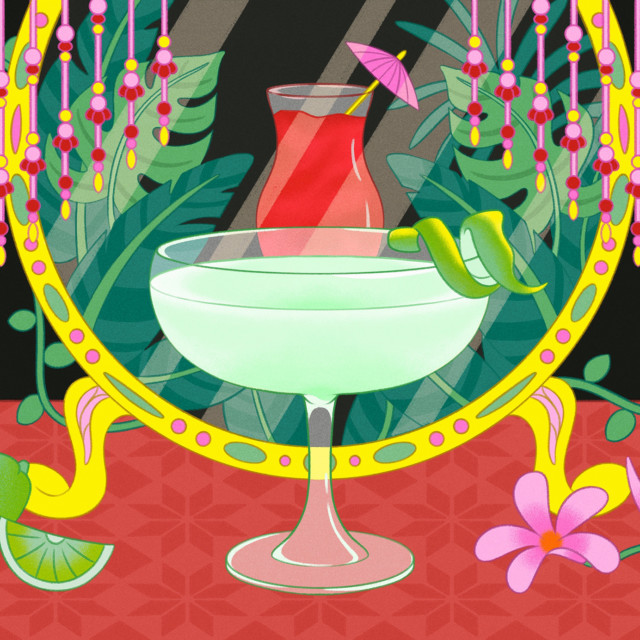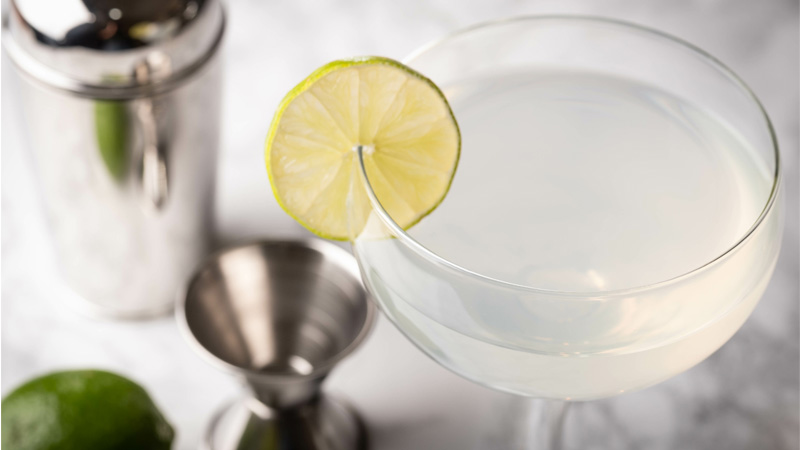For most Americans, the Daiquiri is synonymous with a tropical-themed day drink. It’s typically served frozen, infused with strawberry flavors, and topped with a mini umbrella for good measure.
But in Caribbean and tiki cultures, as well as among drinks industry insiders, the Daiquiri is something else entirely: a simple, three-ingredient cocktail with rum, citrus, and sugar. It’s served up, not frozen, and shares similar construction to a Gimlet or Margarita. The classic Daiquiri is a beloved “industry handshake” between bartenders, and looks nothing like a strawberry smoothie.
Rum and tiki experts in the United States and abroad agree that a well-made Daiquiri is clean and straightforward in nature — no beach view or blender required. So, how did this time-honored, lime-tinted drink stray so far from its cultural roots? When did it become better known in the States as a pink, sickly sweet slushie?
From its birth in the Caribbean to its transformation at boardwalk bars, here’s how a bartenders’ go-to “snack” earned a stateside reputation as an artificial, summertime slushie — and how a new generation of rum lovers is reclaiming this misunderstood drink.
A Caribbean Tradition
“The Spanish-speaking northern Caribbean is really where the Daiquiri had its genesis,” Marc Farrell, founder of Ten to One rum, says. Originally from Trinidad, Farrell came to the U.S. with a deep understanding of Caribbean culture and — after leaving his job as the youngest vice president of Starbucks in 2018 — launched his own Caribbean rum brand in New York in 2019.
Farrell says the true Daiquiri is revered for its restraint and “crushable” nature. He believes that the vibrant Daiquiris we know today have been suited to the palates of spring breakers and tropical vacationers, who never get the chance to taste a well-balanced Daiquiri.
Ironically, though the frozen drinks most of us in the States associate with Daiquiris bear little resemblance to the original cocktail, it was an American who created the first Daiquiri in Cuba over 100 years ago, says Shannon Mustipher, spirits educator and tiki expert.
In the late 19th century, after the Spanish–American War and Spain’s surrender of Cuba to the Americans, many U.S. mining companies came to Cuba to take advantage of the country’s vast iron supply. This brought a man named Jennings Cox, a mining engineer, to Santiago de Cuba.
As the story goes, Cox had company over for Gin and Tonics, but soon ran out of gin. As a replacement, he reached for a bottle of Cuban rum he received monthly as part of his job perks, Bacardi, and crafted a drink made with the Bacardi, muddled lime wedges, cane sugar, and lime juice. He served it in a highball and named the drink after the nearby Daiquiri Beach.
It was no mistake that the swap worked: To better suit the American palate and appeal to incoming businessmen, Bacardi had created a rum with a special fermentation to add more botanical notes and passed it through the still a few extra times for a lighter, cleaner flavor similar to that of gin or vodka.
By the 1930s, the Daiquiri was a Caribbean staple celebrated among locals and literary expats like F. Scott Fitzgerald and Ernest Hemingway.
“Had Jennings Cox had another bottle of rum, I don’t know if he would have made this drink,” Mustipher says.
A Trade Secret
“[The Daiquiri] is the drink I use as a litmus test for a bar, before I order anything else,” Mustipher says. “I choose that because it’s not a popular drink — so if a bartender knows the recipe, that means they’re probably doing a little bit of research outside of work, which is a good sign.”
It has also become a tradition for bartenders to serve up the drink as a send-off for industry friends. “It’s a fun way of greeting a bartender when they come in, or if you have industry friends that have spent some time at the bar, you usually part ways with a round of ‘snackquiris,’” Mustipher says.
(“Snackquiris,” or mini Daiquiris served in shot glasses, have come to replace the customary shots often shared by drinks pros, in an effort to moderate alcohol consumption.)
But those of us less in the know — even some hospitality workers — still often think of the drink as something frozen, pink, and sugary, she says. “I’d be out and about, and ask for a Daiquiri, and sometimes they’d be like, ‘Aw, sorry, we can’t. We don’t have a blender.’ I’m like, ‘it’s OK, you don’t need one.’”
The Emergence of the Strawberry Daiquiri
Once upon a time, frozen Daiquiris were a well-respected drink. Tiki bar pioneer Trader Vic based the majority of his recipes on the Daiquiri and served his cocktails in a variety of formats, including frozen. But instead of machines intended for bulk production, Vic used blenders to make these cocktails, resulting in a texture that was “more like a frappe, not like a frozen machine Daiquiri,” Mustipher says.
Adding flavor in the form of fruits or other ingredients is an age-old tradition in tiki culture. “A Daiquiri is a simple and easy cocktail to make, but you can just do a couple little things to add a very compelling twist,” Farrell says. His favorite is infusing his simple syrup with tea, herbs, and spices, while for Mustipher, an ideal Daiquiri involves banana liqueur and pineapple juice.
Still, these more traditional frozen and flavored options look nothing like the so-called Daiquiris served at most American bars, which are mass-produced and full of added sugars. These machine-made drinks — though often scoffed at by the pros — are, for better or worse, hugely popular in the U.S.
This is especially true at booze-centric tourist destinations, including New Orleans, where frozen Daiquiris can be purchased at drive-thrus and slurped out of tall go cups.
“Most of the Daiquiris you see around here are a one-gallon syrup — a concentrate, that they add to four gallons of water,” Ramone Martinez, a manager of seven Daiquiri shops in New Orleans’ French Quarter, told a local blog in 2016. “Then they add two bottles of whatever liquor they’ve chosen for that mix. That’s the proportions.”
The same blog post claimed “any given [D]aiquiri shop can bring in up to $50,000 on a really good day. A shop on Decatur Street on New Year’s Eve near the ball drop might sell over $20,000 in that one night.”
At Applebee’s, diners can order a Daq-A-Rita, a $5 combination of a Daiquiri and a Margarita that includes tequila, rum, strawberry flavors, and Margarita mix, while Red Lobster’s Berry Mango Daiquiri is described on its menu as “a fruit smoothie with a rum boost.”
With these beverages representing the category on the menus of some of America’s largest chain restaurants, it’s no wonder that there is a disconnect between the Daiquiris drunk by trade members and those consumed by the average American.
A Lesson From the Margarita
“In the ‘50s and ‘60s, convenience foods were very popular. Products like that were very amenable to mass-produced everything, including Daiquiris you would put in a machine,” Mustipher says.
And though the nation has now embraced farm-to-table culture and consumers care more about what they’re putting in their bodies, the Daiquiri seems to be stuck in time. “Just like the Margarita 10 to 15 years ago, the [Daiquiri] has been co-opted and bastardized on some level by the all-inclusive resorts that serve them up one way,” Farrell says, adding that vacationers then return home with the wrong image of the Daiquiri: a strawberry-pink, machine-made, highly sweetened slushie in the sand.
Farrell believes that this can change. “One of my hopes is that, much in the same way as the Margarita has been able to elevate its position in the everyday consumer consciousness, I think there’s an opportunity to do the exact same thing with the Daiquiri,” he says.
In other words, as the American palate continues to evolve, the Daiquiri is bound to shift in a fresher, more simple direction — with riffs incorporating real muddled fruit, herbs, and spices rather than one-note, store-bought syrups.
Rewriting the Daiquiri’s narrative starts with its recipe. And as was true with the Margarita, Mustipher believes fresh lime juice will be the key to the Daiquiri’s advancement. That should give drinks pros hope for the drink’s future success: While mixes and concentrates were readily adopted by past generations, most conscientious bars today prioritize using fresh ingredients in their drinks.
So, with some of the world’s best cocktail bars — from NYC’s Caffe Dante to London’s Tayēr and Elementary — including Margarita variations on their menus today, perhaps it’s only a matter of time for the Daiquiri to follow its lead.
2 Daiquiri Recipes To Try
The Original Daiquiri Recipe
Anyone among the American majority who has only seen the reddish saccharine Daiquiris from beachside bars’ machines should consider mixing up a classic Daiquiri at home. All you’ll need is simple syrup, fresh lime juice, and, of course, a quality rum. While any white rum will do, Mustipher suggests Denizen, Plantation 3 Stars, Probitas, or Diplomatico Planas for a top-notch Daiquiri. Shake, strain, and sip a Daiquiri unlike any you’ve had before.
Shannon Mustipher’s La Floridita Recipe
To drink like Ernest Hemingway, shake up Shannon Mustiphehr’s La Floridita recipe, which subs simple syrup for white sugar. The result is endlessly sessionable and is an ultimate crowd-pleaser.
This story is a part of VP Pro, our free platform and newsletter for drinks industry professionals, covering wine, beer, liquor, and beyond. Sign up for VP Pro now!

